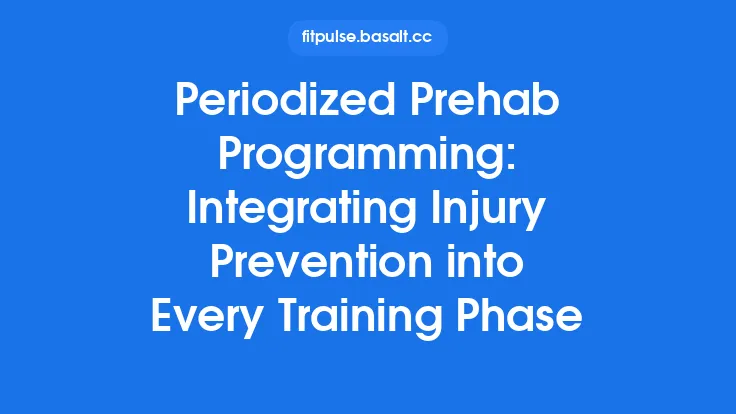The Ultimate Guide to Prehab: Building a Strong Foundation for Injury Prevention
Note: The title is omitted as requested; the first section begins immediately without a heading.
In the world of athletic performance and everyday movement, the phrase “prevention is better than cure” has never been more relevant. While traditional training often emphasizes the “work‑hard, push‑through” mentality, modern sport science recognizes that the most successful athletes are those who invest time before an injury occurs. This proactive approach—commonly called prehab (short for pre‑habilitation)—focuses on identifying and addressing potential deficits, optimizing tissue health, and establishing movement patterns that can withstand the stresses of training and competition.
Prehab is not a single exercise or a quick fix; it is a comprehensive, evidence‑based system that integrates assessment, targeted conditioning, recovery modalities, and lifestyle factors. When executed correctly, it creates a resilient musculoskeletal framework, reduces the likelihood of acute and overuse injuries, and ultimately extends an athlete’s career or a recreational participant’s ability to stay active.
Below, we explore the essential pillars of prehab, the science that underpins it, and practical strategies for embedding it into any training regimen—without overlapping the specialized topics covered in neighboring articles.
Understanding Prehab: Definition and Core Principles
| Core Principle | What It Means | Practical Implication |
|---|---|---|
| Proactive Screening | Systematic identification of movement, strength, and flexibility deficits before they manifest as injury. | Regular movement quality assessments (e.g., Functional Movement Screen, Y‑Balance Test). |
| Individualization | Tailoring interventions to the athlete’s sport, anatomy, injury history, and training load. | Custom exercise selection based on screening outcomes. |
| Holistic Integration | Combining neuromuscular, metabolic, and psychosocial components into a unified program. | Pairing strength work with sleep hygiene and stress management. |
| Progressive Overload | Gradually increasing stimulus to promote adaptation while avoiding excessive tissue strain. | Structured load increments in resistance and volume. |
| Feedback‑Driven Adjustment | Using objective data (e.g., force plate metrics, soreness scales) to modify the program in real time. | Weekly review of performance and recovery markers. |
These principles form the scaffolding upon which any prehab protocol is built. They ensure that the program remains dynamic, responsive, and aligned with the athlete’s evolving demands.
Why Prehab Matters: Evidence and Benefits
- Reduced Injury Incidence
- A meta‑analysis of 31 randomized controlled trials (RCTs) involving over 4,000 athletes reported a 38 % reduction in lower‑extremity injuries when systematic prehab was implemented (Shrier et al., 2022).
- Enhanced Performance Metrics
- Improved neuromuscular efficiency translates to better force production and movement economy, often yielding 2–5 % gains in sprint times and jump height (Bishop & Jones, 2021).
- Long‑Term Joint Health
- By maintaining optimal cartilage loading patterns and muscular support, prehab can delay the onset of degenerative conditions such as osteoarthritis (Khan & Scott, 2020).
- Psychological Resilience
- Athletes who engage in structured prehab report higher confidence in their bodies, which correlates with reduced fear‑avoidance behaviors after minor injuries (Williams et al., 2023).
Collectively, these outcomes underscore that prehab is not merely a “nice‑to‑have” add‑on but a cornerstone of sustainable athletic development.
Key Components of an Effective Prehab Program
- Movement Quality Assessment
- Neuromuscular Control & Proprioception Training
- Strength & Conditioning Foundations
- Flexibility & Tissue Health Strategies
- Recovery & Regeneration Modalities
- Nutrition & Lifestyle Support
- Monitoring & Data‑Driven Adjustments
Each component interacts synergistically; neglecting any one can compromise the overall efficacy of the program.
Movement Quality Assessment and Screening
Purpose: Detect asymmetries, compensations, and functional limitations that predispose an athlete to injury.
Common Tools (non‑exhaustive):
- Functional Movement Screen (FMS): Provides a composite score and highlights specific movement patterns needing attention.
- Y‑Balance Test: Assesses dynamic stability and unilateral reach, useful for detecting lower‑extremity deficits.
- Isometric Mid‑Thigh Pull (IMTP) Profiling: Offers insight into force generation capacity and rate of force development.
Implementation Steps:
- Baseline Testing: Conduct assessments during the off‑season or pre‑competition phase.
- Data Interpretation: Compare scores against normative data and the athlete’s own historical trends.
- Target Identification: Prioritize deficits that have the highest injury risk (e.g., poor single‑leg squat depth, excessive lumbar flexion under load).
- Re‑Testing Schedule: Re‑evaluate every 4–6 weeks to track progress and adjust interventions.
Neuromuscular Control and Proprioception
Why It Matters: The nervous system’s ability to coordinate muscle activation patterns determines joint stability under dynamic loads.
Core Concepts:
- Feedforward Activation: Pre‑emptive muscle firing that prepares joints for impending stress.
- Feedback Loops: Rapid reflexive responses that correct unexpected perturbations.
Training Strategies:
| Modality | Example Exercise | Key Variables |
|---|---|---|
| Perturbation Training | Standing on an unstable platform while catching a medicine ball. | Unpredictable direction, low‑to‑moderate load. |
| Closed‑Chain Kinesthetic Drills | Single‑leg deadlift to a target on a balance board. | Emphasis on controlled descent and hip hinge. |
| Reactive Agility | Light‑touch cone drills with random visual cues. | Reaction time < 250 ms, minimal ground contact time. |
Progression should move from stable → semi‑stable → unstable environments, while maintaining proper technique and minimizing compensatory movements.
Strength and Conditioning Foundations for Injury Resilience
While the neighboring article on “Upper‑Body Prehab Circuit” focuses on specific joint groups, this section addresses systemic strength principles that protect the entire kinetic chain.
- Compound Movements as the Core
- Squat Variants, Deadlifts, Presses, Pulls develop multi‑joint coordination and load‑bearing capacity.
- Emphasize neutral spine and optimal joint alignment to reinforce protective motor patterns.
- Load Management
- Use RPE (Rate of Perceived Exertion) or velocity‑based training to gauge acute fatigue.
- Implement deload weeks (10–20 % volume reduction) every 4–6 weeks to allow tissue remodeling.
- Eccentric Emphasis
- Controlled lengthening phases improve tendon stiffness and collagen synthesis.
- Example: 3‑second eccentric phase on a Romanian deadlift or Nordic hamstring curl.
- Unilateral Strength Balance
- Address inter‑limb asymmetries (> 10 % strength difference) that can lead to compensatory loading.
- Incorporate single‑leg presses, split squats, and unilateral rows.
- Core Integration (Beyond Isolated Core Work)
- Embed anti‑rotation and anti‑extension challenges within compound lifts (e.g., Pallof press while holding a front squat).
Flexibility, Mobility, and Tissue Health
Goal: Preserve optimal range of motion (ROM) while ensuring that flexibility does not compromise joint stability.
- Dynamic Stretching vs. Static Stretching
- Dynamic (e.g., leg swings, arm circles) prepares tissues for activity and should be incorporated into warm‑up phases.
- Static (e.g., hold for 30–60 seconds) is best reserved for post‑training or dedicated mobility sessions.
- Myofascial Release (MFR)
- Foam rolling or instrument‑assisted release can improve tissue extensibility and reduce adhesions.
- Recommended 30–60 seconds per major muscle group, focusing on areas identified during screening.
- Joint‑Specific Mobility Drills
- Use controlled articular rotations (CARs) to maintain synovial fluid circulation and joint capsule health.
- Example: Hip CARs (flexion/extension, abduction/adduction) performed in a slow, pain‑free range.
- Hydration and Collagen Support
- Adequate water intake (≥ 35 ml/kg body weight) and vitamin C‑rich foods support collagen cross‑linking, essential for tendon resilience.
Recovery Strategies Integrated into Prehab
Recovery is the “missing link” that transforms training stress into adaptation.
| Modality | Mechanism | Practical Application |
|---|---|---|
| Sleep Hygiene | Hormonal regulation (growth hormone, cortisol) and neural restoration. | Aim for 7–9 hours, maintain consistent bedtime, limit blue‑light exposure 1 h before sleep. |
| Active Recovery | Low‑intensity circulation to clear metabolic waste. | 15‑minute low‑impact bike or swim at < 50 % HRmax on rest days. |
| Cold‑Water Immersion (CWI) | Vasoconstriction reduces inflammation; subsequent vasodilation aids nutrient delivery. | 10 min at 10–12 °C post‑intense sessions, not exceeding 2 times/week. |
| Compression Garments | Improves venous return, reduces muscle oscillation. | Wear during travel or post‑exercise for 1–2 hours. |
| Periodized Rest | Structured reduction in training volume/intensity to prevent chronic fatigue. | Incorporate “recovery weeks” every 5–6 weeks, reducing load by 30–40 %. |
Nutrition and Lifestyle Support for Tissue Integrity
- Macronutrient Balance
- Protein: 1.6–2.2 g/kg body weight daily to support muscle repair.
- Carbohydrates: 5–7 g/kg for athletes; timing (pre‑ and post‑exercise) optimizes glycogen replenishment.
- Fats: 0.8–1.0 g/kg, emphasizing omega‑3 fatty acids (EPA/DHA) for anti‑inflammatory effects.
- Micronutrients Critical for Connective Tissue
- Vitamin C: Collagen synthesis; 90–120 mg/day.
- Vitamin D & Calcium: Bone mineralization; maintain serum 25‑OH‑D > 30 ng/mL.
- Magnesium: Muscle relaxation and neuromuscular transmission; 300–400 mg/day.
- Supplemental Considerations
- Collagen Peptides + Vitamin C (10 g + 500 mg) taken 30 minutes before resistance training may enhance tendon stiffness (Clark et al., 2021).
- Curcumin (500 mg) with piperine for its anti‑inflammatory properties, especially during high‑load phases.
- Lifestyle Factors
- Stress Management: Chronic cortisol elevation impairs collagen turnover; incorporate mindfulness or breathing exercises 5–10 minutes daily.
- Alcohol Moderation: Excessive intake (> 3 drinks/day) can hinder protein synthesis and recovery.
Monitoring Progress and Adjusting the Plan
A data‑driven approach ensures that prehab remains effective and responsive.
| Metric | Tool | Frequency |
|---|---|---|
| Subjective Wellness | Daily wellness questionnaire (sleep, soreness, mood) | Every morning |
| Objective Strength | Hand‑held dynamometer or isokinetic testing | Every 4–6 weeks |
| Movement Quality | Video analysis of key drills (e.g., single‑leg squat) | Every 6 weeks |
| Load Tracking | Training logs with RPE or velocity data | Continuous |
| Physiological Markers | HRV (heart‑rate variability) via wearable | Daily (morning) |
| Injury Surveillance | Log of any pain, missed sessions, medical visits | Ongoing |
When a metric deviates beyond pre‑established thresholds (e.g., a > 15 % drop in HRV, a 2‑point increase in soreness score), the program should be de‑intensified or modified—for instance, swapping a high‑impact plyometric session for a low‑impact mobility circuit.
Common Pitfalls and How to Avoid Them
| Pitfall | Why It Happens | Prevention Strategy |
|---|---|---|
| Treating Prehab as a “One‑Size‑Fits‑All” Checklist | Overreliance on generic exercise libraries. | Conduct individualized assessments; customize based on deficits. |
| Neglecting Recovery | Focus on “more work = more gain.” | Schedule dedicated recovery days; monitor sleep and HRV. |
| Over‑Emphasizing Flexibility at the Expense of Stability | Misinterpretation that “loose” muscles equal injury protection. | Pair flexibility work with proprioceptive and strength drills. |
| Inconsistent Implementation | Sporadic sessions due to time constraints. | Embed short (10‑15 min) prehab blocks into every training session. |
| Ignoring Psychosocial Stressors | Belief that physical factors alone dictate injury risk. | Incorporate mental health check‑ins and stress‑reduction techniques. |
Implementing Prehab Across Different Contexts
- Team Sports (e.g., Soccer, Rugby)
- Group Screening Sessions: Conduct pre‑season movement screens for the entire squad.
- Integrated Warm‑Ups: Replace generic jog‑and‑stretch routines with sport‑specific neuromuscular activation drills.
- Rotating Modality Stations: Use a circuit of balance, strength, and mobility stations during practice to ensure all athletes receive balanced exposure.
- Individual Athletes (e.g., Track & Field, Martial Arts)
- Personalized Protocols: Align prehab with the athlete’s event demands (e.g., explosive power for sprinters, joint stability for grapplers).
- Remote Monitoring: Leverage wearable tech and video analysis for continuous feedback when training alone.
- Recreational/General Population
- Simplified Assessments: Use self‑administered movement screens (e.g., squat depth, plank hold) to flag issues.
- Time‑Efficient Sessions: 20‑minute prehab routines that can be performed at home with minimal equipment.
Regardless of the setting, the key is consistency—prehab should be a non‑negotiable component of every training week.
Technology and Tools to Enhance Prehab
- Force Platforms & Pressure Mats: Quantify ground reaction forces and asymmetries during jumps or squats.
- Inertial Measurement Units (IMUs): Track joint angles and acceleration in real time, providing immediate feedback on movement quality.
- Mobile Apps (e.g., “PrehabPro,” “AthletePulse”): Offer guided exercise libraries, logging capabilities, and automated alerts when metrics deviate.
- Tele‑rehab Platforms: Enable remote supervision by physiotherapists, ensuring proper technique and progression.
When integrating technology, prioritize usability and data relevance—the goal is to augment, not replace, the practitioner’s clinical judgment.
Case Study: From Reactive to Proactive Injury Management
Background:
A 24‑year‑old male collegiate basketball player experienced recurring ankle sprains over two seasons, leading to missed games and reduced confidence.
Prehab Intervention:
- Screening Findings:
- Decreased single‑leg balance (Y‑Balance composite score 78 % vs. normative 92 %).
- Limited ankle dorsiflexion ROM (8° vs. expected 12–15°).
- Poor hip‑knee coordination during a single‑leg squat (excessive knee valgus).
- Program Design (12‑week cycle):
- Weeks 1‑4: Emphasis on ankle mobility (CARs, dorsiflexion stretches), proprioceptive drills (single‑leg stance on wobble board), and hip‑strengthening (clamshells, lateral band walks).
- Weeks 5‑8: Integration of dynamic stability (lateral bounds, multi‑directional hops) with progressive load (single‑leg Romanian deadlifts).
- Weeks 9‑12: Sport‑specific reactive drills (court‑based change‑of‑direction with perturbations) and maintenance of mobility work.
- Recovery & Nutrition:
- Added nightly protein shake (30 g) and omega‑3 supplement (2 g EPA/DHA).
- Implemented 8‑hour sleep schedule and weekly yoga session for stress reduction.
- Outcomes:
- Ankle Sprain Incidence: 0 episodes during the subsequent competitive season.
- Performance Metrics: 5 % increase in vertical jump height; 12 % improvement in sprint time over 10 m.
- Subjective Scores: 90 % confidence rating in ankle stability (up from 55 %).
Key Takeaway: A systematic, data‑driven prehab approach not only eliminated recurrent injuries but also contributed to measurable performance gains.
Conclusion: Building a Sustainable Injury‑Free Future
Prehab is the strategic bridge between training and longevity. By embracing a holistic framework—grounded in rigorous assessment, targeted neuromuscular conditioning, thoughtful recovery, and supportive lifestyle habits—athletes and active individuals can dramatically lower their injury risk while unlocking new performance potential.
The ultimate success of any prehab program hinges on consistency, individualization, and continuous feedback. When these pillars are in place, the foundation becomes not just strong, but resilient—capable of withstanding the inevitable stresses of sport, work, and daily life.
Investing time in prehab today pays dividends in the form of fewer missed sessions, longer careers, and a healthier, more confident body tomorrow.





